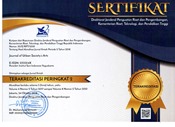Narrative and Cinematic Aspects in Commercial and Art Films as Directors’ Artistic Treatments: a Comparative Study
Abstract
Data shows that award-winning films are not always the best-selling films and vice versa. Therefore, it is interesting to investigate whether the director employs different art techniques for commercial and art films. This qualitative textual study examines the artistic treatments of both films and compares the narrative aspects of the story and the cinematic elements related to the film presentation techniques. The narrative aspects include (a) plot, (b) premise, (c) characters, and (d) conflict. The cinematic elements include (a) cinematography, (b) editing, (c) sound, and (d) setting. The results show that the director applies different art techniques for different films. For films orientated to commercial movie theaters, the narrative is more complex but presented in a cinematic that is easier for the audience to understand. For films in festivals, the narrative is more simple, but the cinematic aspect are more complex. These findings support the results of the data control, a combination of the best- selling and award-winning films, which shows that the film has a rather complex narrative and visualizations but is relatively easy to understand.
Aspek Naratif dan Sinematik dalam Film Komersial dan Film Seni Sebagai Olah Artistik Sutradara Film. Data menunjukkan bahwa film yang meraih banyak penghargaan di festival bukanlah film yang laris di bioskop serta sebaliknya. Fenomena ini menarik untuk diteliti dengan mengkaji apakah sutradara menerapkan perlakuan artistik yang berbeda antara film yang ditujukan untuk ditayangkan di bioskop dan film yang dikirim ke festival. Penelitian tekstual ini mengkaji pengolahan artistik yang dilihat dari dua aspek yaitu aspek naratif yang berkaitan dengan cerita serta aspek sinematik yang berkaitan dengan teknik penyajian film. Hasil yang didapatkan memperlihatkan bahwa sutradara mengolah artistiknya secara berbeda pada kedua ranah tersebut. Di ranah bioskop naratifnya lebih kompleks namun disajikan dalam sinematik yang lebih mudah dipahami penonton, sementara di ranah festival, naratifnya lebih sederhana tetapi olahan sinematiknya lebih kompleks. Hasil ini dipertegas dengan hasil kontrol data di ranah gabungan yang memberikan naratif yang agak kompleks melalui sajian yang agak kompleks namun juga relatif mudah dipahami.
Keywords
Full Text:
PDFReferences
Adimasara, B. P. (2020). Setting sebagai Penunjuk Status Sosial dalam Film Athirah. http:// repository.isi-ska.ac.id/4585/
Bordwell, D., & Kristin Thompson. (2008). Film Art: An Introduction (8th ed.). US: McGraw- Hill.
Egri, L. (1960). The Art of Dramatic Writing. USA: Touchstone.
Giannetti, L. (1993). Understanding Movies (6thed.). Singapore: Prentice Hall.
Haryanto, D. (2011). Semiotika Film Laskar Pelangi. Dewa Ruci, 7(1), 161–179. https:// doi.org/10.331.53/dewaruci.v7i1.985
Maijar, A. (2018). Film “Tropy Buffalo” Sebagai Sebuah Parodi Kebudayaan Minangkabau Dalam Estetika Posmodern. Journal of Urban Society’s Arts, 5(1), 29–36. https://doi. org/10.24821/jousa.v5i1.2199
Oktaviani, D. D., & Nugroho, S. (2016). Pola Karya Konvensi pada Film Sekuel Studi Kasus Film Ada Apa Dengan Cinta? 2. Jurnal Kajian Seni, 3(1), 81–94. https://jurnal.ugm.ac.id/ jks/issue/view/3107
Rawung, L. I. (2013). Analisis Semiotika pada Film Laskar Pelangi. Jurnal Acta Diurna Komunikasi, 2(1). https://ejournal.unsrat. ac.id/index.php/actadiurnakomunikasi/ article/view/976/791
Santoso, V. (2017). Kapital dan Strategi Garin Nugroho dalam Proses Produksi Film. Journal of Urban Society’s Arts, 4(1), 11–18. https:// doi.org/10.24821/jousa.v4i1.1492
Seger, Linda. (1987). Making A Good Script Great.Samuel French.
Siautta, S. Y. et al. (2020). Selubung Ketidakadilan Peran Gender dalam Motherhood pada Film Athirah. Jurnal Tuturlogi, 1(3), 165–183. https://tuturlogi.ub.ac.id/index.php/ tuturlogi/article/view/66
Tiaratama, E., & Pamungkas, I. N. A. (2017). Peran Generasi Y sebagai Talkers pada Generasi Z. Menciptakan Word of Mouth (WOM) Film Ada Apa Dengan Cinta 2 (AADC 2).
www.filmindonesia.or.id. (n.d.).
DOI: https://doi.org/10.24821/jousa.v8i2.5745
Refbacks
- There are currently no refbacks.

This work is licensed under a Creative Commons Attribution 4.0 International License. ISSN 2355-2131 (print) | ISSN 2355-214X (online).







